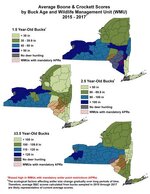This is an issue of many factors, hunter preference as well as habitat. Not the least of which is that 99% of the whitetail "media" out there is based on something (private, heavily-managed land in midwest ag areas) that simply isnt even in the same solar system of reality for many of us. It IS easy for a newer hunter to get discouraged because "everyone" says they should be doing this or seeing that, and it simply doesnt apply universally. It sets an unrealistic expectation for tons of folks. Obviously its up to all of us to level-set expectations and apply what we read to our own situation, but I've seen this numerous times, and 100% it is unhelpful.Were I deer hunt, there has NEVER been a 125" buck killed or even on any of our cameras in the past 10 years.
I know that if I want to shoot a buck, I need to be willing to shoot something in the 100-120" range. They will simply NOT live to be bigger than 125" where I hunt. 10 years, meticulous record keeping and 20 trail camera have proven that. We have tried letting deer live and the neighbors kill them. Always hated saying that but in my area it is 100% true.
Example based on actual data here that I saw recently, this post reminded me of it--I have literally seen multiple people APOLOGIZING for taking a "little" 100" deer where I often hunt (basically center of the dark green area at the North end of the 1st map), when in reality that deer might very realistically be fully mature, it just happens to live in an area with a super-short growing season, harsh winters, infertile soil, large Wilderness areas with no logging, and zero agriculture. Context is everything.
link

